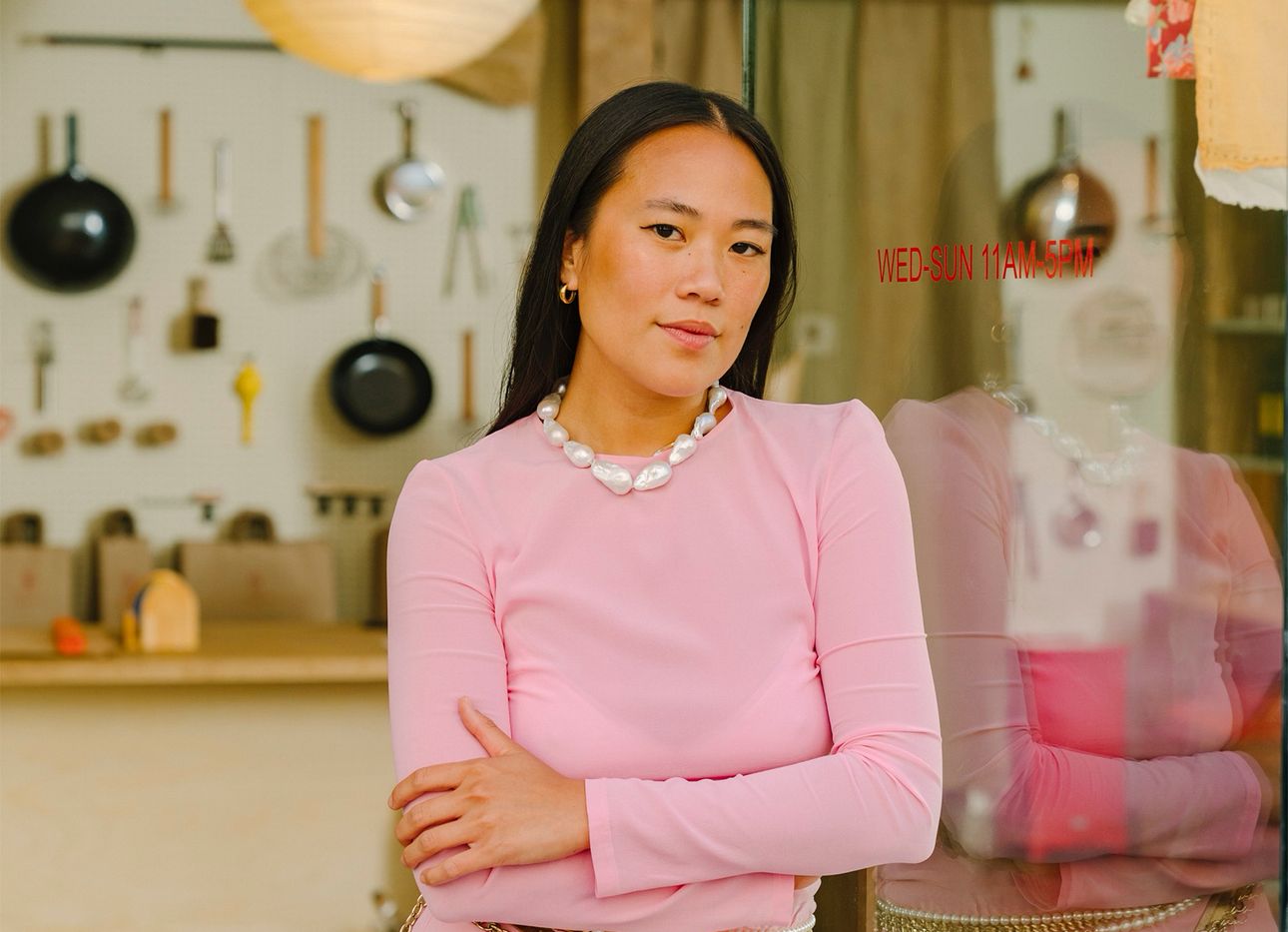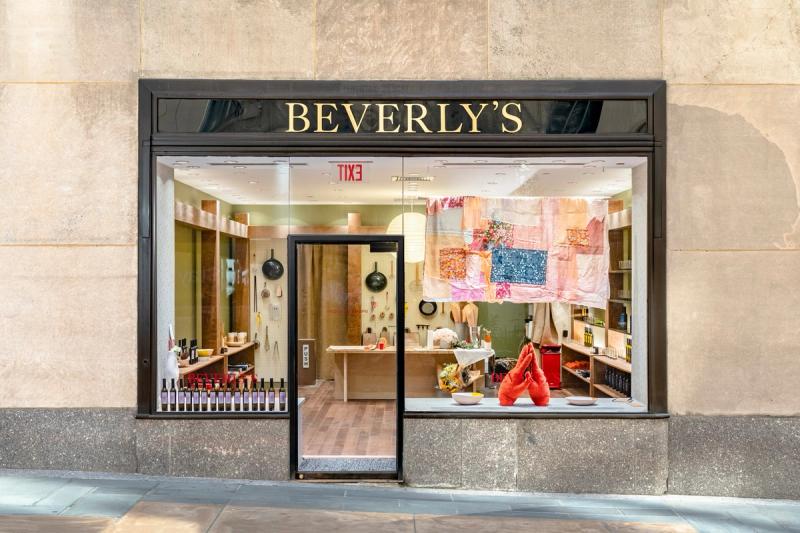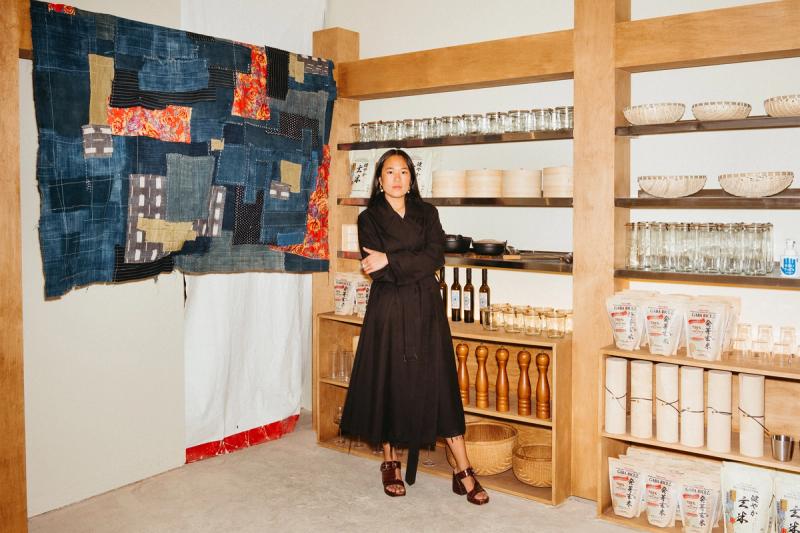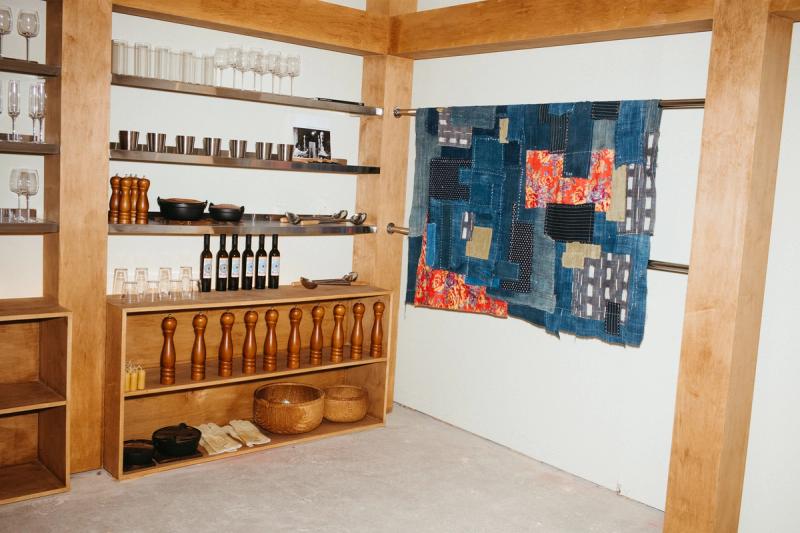
Beverly Nguyen’s Highly Tactile Taste in Media
Defying the pull of our digital, largely two-dimensional age, the New York–based stylist and shop owner Beverly Nguyen tends to gravitate toward tactility in all aspects of her life. Having established her career in the fashion world with positions at Vogue, Opening Ceremony, and La Garçonne; as an assistant and later studio director of the stylist Kate Young (the guest on Ep. 3 of Time Sensitive); and now as a professional stylist herself, Nguyen has in recent years plunged headlong into a new small business, her namesake homewares store Beverly’s NYC. Lining the shelves of the specialty market are wooden spoons, brooms, baskets, and pepper grinders—many of these items sourced from local Chinatown vendors—as well as her own custom extra virgin olive oil.
Following its manifold iterations over the past two years—first, in April 2021, as a pop-up shop on Ludlow Street on Manhattan’s Lower East Side; then as a pop-up at Rockefeller Center; then as a section in Nordstrom’s home goods department at its Midtown flagship; and then, in 2022, as three different pop-ups within the span of four months—the shop is soon to settle into its permanent home at 27 Orchard Street. Serendipitously, the shop’s final destination, expected to open next month, is just one street over from its very first pop-up location. To Nguyen, this full-circle trajectory feels inevitable in hindsight: “After having a shop in Midtown at Rockefeller and at Nordstrom, and then having an understanding of what it was like to be in a Lower East Side location [with my first pop-up]—especially working with a lot of Chinatown vendors and friends who are all downtown or in Brooklyn—I was just like, You know what? I need to be where my friends, community, vendors, artists, where I live, where I eat, where I hang out. For me, that’s downtown.”
With two jobs that revolve around up-and-coming brands, designs, and talent, it’s impossible for Nguyen to fully escape social media and the internet vortex. But when she can, she does. “I tend to look at tangible things in my day, because in the last decade of my life, I spent so much time on Instagram looking for young designers and new brands and talent and interesting things that were happening on the internet,” she says. Starting her days with a 20-minute meditation, Nguyen has a strict no-phone-in-bed policy and has omitted a television in her living room layout. She prefers to have her nose in magazines and catalogs rather than pointed toward a screen, and finds herself attending matinees at local theaters instead of tuning in to Netflix or HBO shows.
Here, we speak with Nguyen about the tactile, often sensory media she consumes, which includes the annual fashion journal Vestoj, mastheads and indexes of old magazines, and the physical newspaper.
How do you start your mornings?
I have a different morning program depending on the time of year. Right now, since I’m staying in New York in August, I have to carve out my own breaks, and I usually like to take one in the morning. I get up around 5:30 or 5:45, and I go straight to a meditation before anything. I meditate for twenty minutes. Then I drink a ton of water, and I stretch. I don’t typically look at my phone until after that meditation, unless somebody I’m dressing or styling is in a different time zone—in that case, I would have been up an hour or two hours before that. But since everybody is on strike [laughter]—since I’m not dressing any celebrities at the moment—I start there, and then I’ll check my phone and I’ll have my coffee.
Where do you get your news?
I always listen to NPR in the morning. I’ll either turn on Aretha Franklin or blast NPR through the bathroom while I’m washing my face. [Laughs] Then, once I look at my phone, I get all the New York Times alerts. I just scroll through the news and see what’s happened in the world, and in New York. I also get the newspaper every day, so I usually check that. I’m a big print person.
I think you might be the first person I’ve talked to on this series who gets the physical newspaper.
Really? Well, one of the weird reasons I opened the store—there are so many reasons I opened the store—but at the time when I was really getting into it was because I was in a fight with The New York Times. Because I had moved addresses, and it takes them six months to really begin resending you the paper. I thought that if I opened the store, I could just carry the paper and actually have the Times every day sent to the store. But I found out it is extremely difficult, and it’s a big waste of money to do that, because for every issue that doesn’t sell, you have to spend your own money sending it back to the printer. That’s why it’s very rare to find the New York Times or any kind of daily newspaper at most of your bodegas.
Interesting. Back to the digital world, do you have any favorite newsletters?
I actually love The Slowdown’s newsletter. I look forward to that. I also love the New York Times Cooking newsletter, like “Five things to make in a week.” I love to cook, so I read any food newsletters that come through.
Is there a recipe that you’ve made recently from one of those newsletters?
I just came back from Eataly, because I’m going to make a vongole tonight, but as I was coming downtown back to my apartment, there was one [newsletter] that I flipped through and it has this delicious Yucatán Mexican grilled pork chop. It’s called poc chuc, and it looks so delicious. There’s orange and grapefruit and lime juice—super citrusy. I feel like those recipes that they offer are for the modern working person. You can pick up these ingredients at any grocery store, and the images are so pretty, but actually realistic and attainable.
I also always read a little recap from Women’s Wear Daily. Another thing that I enjoy that I don’t think most people get, unless you’re in the world of fashion, or you’re an editor or stylist, is a lot of press releases. Every day, I get, like, twenty-five of them. I really enjoy reading press releases from luxury fashion houses. Balenciaga releases, probably once every two weeks, a press release of some sort, and it’s so beautifully written. That press release is truly a form of art—the way they capture and sell what they’re releasing without images. It’s just very old school. I almost read it like a memo.
Any favorite magazines?
I have so many. I love Pin-Up. I’m very attached to Felix [Burrichter], the founder. Do you know him?
I actually interviewed him for this very series, maybe a year and a half ago.
Oh! I had no idea. I look forward to reading the actual articles in Pin-Up. They highlight incredible and versatile designers and professors and people who are up and coming, and they have a good point of view. It’s worth spending money on print for that. I also read a lot of System Magazine. Those interviews are long, and they’re beautiful.
I love newreader.net. That’s something I really, really love that comes close to the Uline catalog, in that it’s a digital library archive. It profiles certain friends and people in their community and network who have done incredible things with their work, and how they archive their work, and how they research their work, [whether it be] a musician or a writer or an architect. It’s visually simple and so visually beautiful that it makes it easy to digest.
HommeGirls is another favorite. I work with them a lot. I love the foundation of the magazine. It’s much more visual, photo heavy. So much of my work, whether it’s the store or fashion, is seeing who’s up and coming, and seeing how people are portraying old luxury brands with a new way of styling for fashion, and how it’s working with younger actresses or actors or designers. So it’s fun to see their point of view and their vision. The magazine’s fashion director, Stella Greenspan, has really polished the magazine, I feel.
Another print that I always look forward to getting is Vestoj. It’s a journal that comes out annually. It’s not pretentious at all. The back of it has a manifesto, and it’s like, “Advertising is forbidden, everything will be questioned,” you know, “fashion must always be taken seriously.” But it’s actually pretty witty and cheeky. Part of it is dissecting the zeitgeist, what’s happening in the world. One thing could be on authenticity, or they’ll have Demna interviewed, or they’re having Miuccia Prada interviewed, or they’ll have Mike Eckhaus and Zoe Latta of Eckhaus Latta interviewed, and they give their personal advice on how they built their career on trying to be authentic. It’s not just cheesy or pretentious. It’s actually very digestible. It gives fashion a little space for philosophy.
Also, now that I spend relatively less time on social media platforms and websites versus paper—and also because I’m opening the store—I spend a lot of time looking at catalogs. Me and the Uline catalog are pretty close. I’m really into looking at inventory lists, and images, and quantities, and graphics.
Any favorite podcasts?
I listen to Time Sensitive and At a Distance over and over again. If I fly, and I’ve downloaded an episode, I listen to it multiple times. I just love the amount of research that goes into them. It’s really psychotic to get to the point of interviewing somebody where you get really deep and don’t ask surface-level questions. It challenges the interviewer to think, What’s next? They’re coming up with more emotions than you’d think. I love that kind of dialogue. The one with Deborah Needleman was incredible.
I’m also a really big, newfound lover of Dua Lipa’s At Your Service. I don’t know if somebody is ghostwriting her questions, but she really has a true journalistic, articulate way of speaking to somebody that reaches them on a personal, real level. There are niceties and there are manners, and I think you have to maintain that in some regard. But there’s also some push. She actually centers a lot around upbringing and culture and identity and any traumas, but it doesn’t feel invasive. It doesn’t feel like the way Oprah comes in to rip you down and get you to expose everything. She’s just like, “Let’s talk about it.” She’s very relatable.
Then, of course, I’m a fashion girl. So I do like the Vogue Run-Through. [The hosts] Chioma [Nnadi] and Chloe Malle are pretty hilarious. They’re so different, and they’re so light.
Any favorite TV shows?
I haven’t been watching too many heavy HBO or Netflix shows. But I watch a lot of YouTube. I learn to build furniture, and I have an interest in it. Since I’m opening the store, I learn how to polish floors, how to change a gas pipe if I need to. I’m just studying how to do all of this, even though I have no training background in design or architecture or an interior design license. I was just like, Okay, let me watch YouTube.
People call it “YouTube University.”
On more than one occasion, I’ve had to change the entire toilet. So I’ve taken a lot of YouTube courses on how to change a toilet. The most unexpected one with like zero views is usually the best one for me.
There’s also this girl named Dianxi. She’s a 20-year-old cook in China who lives on a farm, and she doesn’t speak, and they’re sixteen minutes an episode. She cooks for her family and her dog, and she forages everything. It is stunning. She forages peppercorns, she hunts her own meat, she pickles cabbage. She prepares all these four-course meals for her family, and she does it all over an open fire. She’s half my size, and she’s climbing sugarcane, you know? She’s become a bit of a star now, which is hilarious, because it’s just her by herself and her little brother and the dog and the parents, and no one’s speaking. She wasn’t always big. I’ve been watching her for probably five years or something. I feel like I relate to her. That’s how I want to be cooking, but I’m really using, like, an Our Place plan. Each one ends with her calling her parents over to eat. Sometimes it’s nighttime, and they’re outside, and it’s just so mundane. But it makes me miss my family. We’re unpacking my TV behavior. [Laughs]
Any favorite recent films?
One of my favorite things to do is to see a matinee. I have my own schedule, and sometimes I’ll be like, “I have a two-hour meeting,” but it’s actually a movie. I guess it’s kind of research. So recently in theaters I saw Past Lives, which I thought was so beautiful. I thought Greta Lee was incredible. I watch a lot of films at IFC and Film Forum, because there will be some weeks where they do, like, Wong Kar-wai only, and you can watch a triple feature.
What book or books are you currently reading?
There’s an author, Adam Phillips. He’s a therapist and a philosopher. He has a book called Missing Out. I pretty much read it every season—at least once in the winter, once in the spring, once in the summer, once in the fall. I usually travel with it. I highly recommend it. It’s like an early version of teaching us how to not have FOMO, and searching for the life unlived. A lot of times we wish we were living someone else’s life. It’s sort of teaching you how to control and think about not wanting those things. He speaks on romanticizing your own life and your own relationships versus longing for something that you’ve never experienced.
I was also just reading The Mindful Athlete, which is a book [by George Mumford] about Phil Jackson and how he got the [Bulls and the] Lakers to win all of their championships through meditation.
Any favorite social media accounts?
I’m really scandalous with Instagram. Sometimes I’m like, if people saw what I liked, it would be really weird. I’m all over the map, because you’re just being offered so much information. But the Instagrams I love are funny ones. I love this account @goodshirts. It’s just a T-shirt site, and it shows you all of these crazy sayings on their T-shirts that are just kind of raunchy and inappropriate. It’s a nice break. The graphics are really funny, and it’s a lot of plays on words. And it’s people all over the world—it’s not just in one location, it’s not just New York. It takes place in every country and city, and it’s hilarious.
For inspiration, I like @de_architects_. Just visually stimulating. I love the way they caption everything. There’s a lot of information, and it references the time and the source and the period of the piece that they’re posting about. There’s a lot of interesting banter back and forth between the comment section. I look to that a lot for references.
There’s this one, @sinkreviews, and it’s this guy that comes in and rates bathrooms in the city. The designs of some of them are pretty fabulous. He goes to Grand Central Station, and he goes to Home Depot, and he’s so funny.
What’s one book or other piece of media that you think everyone should consume?
Vestoj. One thing that I look for in reading material and media is allowing everybody to be a part of it. There’s a lot of exclusivity in a lot of media—it’s intimidating and it’s unapproachable sometimes. Especially in fashion, if you’re in it, and you’re aware of it, then you’re jaded by it, and you’re critiquing it, and there are all these different approaches that people take. But Vestoj is such a great introduction for anyone—or just a refresher—if you want to know about fashion. The writing style is so digestible, and it gives respect to fashion while making it very approachable.
Any guilty pleasures?
It’s so dorky. When I was a kid, I lived in Orange County, and I wasn’t around fashion unless it was a magazine. My parents work in fashion, but they did not glamorize it at all. I would read captions—and I still do this now, actually, it’s the one thing that I do that’s a-single-girl-living-alone behavior—and I read the masthead for old magazines all the time. I read captions that were written in the corners of magazines, where they have the price and the description and where you can buy them. That is one of my favorite indulgent things to do. And then I go really weird, and I read the back index. I love that kind of publishy-techy-media thing. That’s how I learned when I was 12 or 13 years old who Grace Coddington was, Anna Wintour. I learned who the beauty assistant was at the time at Vogue. I learned all those roles.
This is a departure from magazines—but one of my favorites is rereading the John Pawson book [Living and Eating], and the back has all the things you need for your kitchen, down to which pan to use for cooking fennel, and which stockpot to use when you’re poaching chicken, what you should make Monday through Friday, and it’s like the last twenty pages of the book. God, that sounds crazy. But that’s my guilty pleasure.


